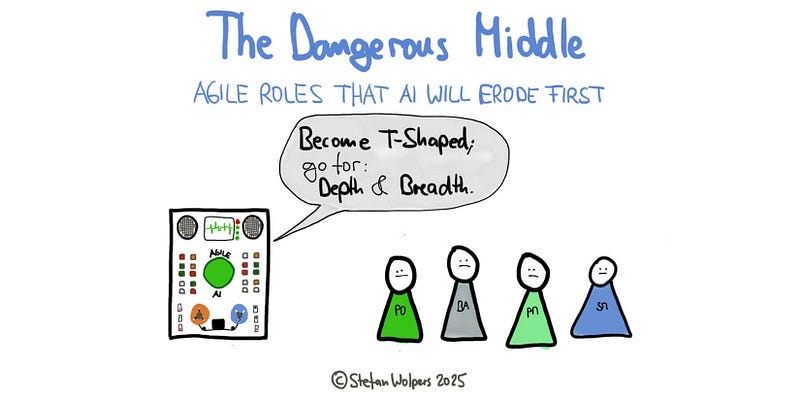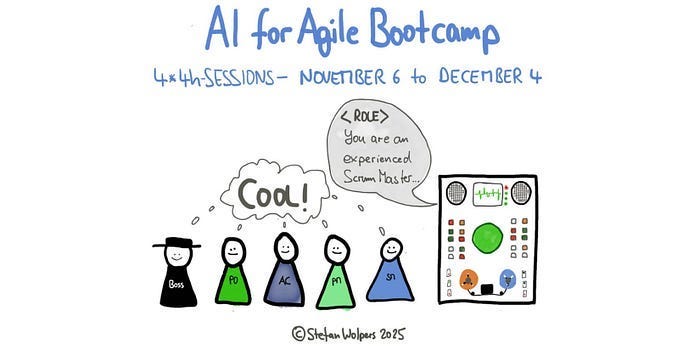The Dangerous Middle: Agile Roles That AI Will Erode First
What Peter Yang's Product Management Framework Reveals About the Future of Scrum Masters and Agile Coaches
Hello everyone!
Peter Yang, a renowned product leader, argues that AI will split product roles into two groups: Generalists who can prototype end-to-end with AI, and specialists in the top 5% of their fields. Everyone else in the dangerous middle risks being squeezed.
How does this apply to agile practitioners: Scrum Masters, Product Owners, Agile Coaches, and transformation leads? Essentially, with important nuances.
Find Peter Yang’s article here: 5 Practical Steps to Future Proof Your Career in the AI Era.
🎓 🛒 The AI 4 Agile Online Course Is Available — Join Now at $ 129 until October 20, 2025: AI 4 Agile — Master AI Integration for Agile Practitioners.
🗞 Shall I notify you about articles like this one? Awesome! You can sign up here for the ‘Food for Agile Thought’ newsletter and join 40,000-plus subscribers.
🎓 Join Stefan in one of his upcoming Professional Scrum training classes!
The Reality of Process Facilitation
Practitioners are exposed if their core value is running Sprint Planning, facilitating Retrospectives, or maintaining Jira backlogs. Tools now automate or support much of this work.
We’ve seen this before. As teams learned to self-organize, demand for “process managers” fell. A similar shift is underway. Organizations may decide they don’t need practitioners whose skills stop at event facilitation. When other leaders can pull templates for Retrospectives, Sprint Planning, and backlog refinement, they ask, “What are we paying a Scrum Master for?” If you can’t answer in business terms, not process terms, you sit in the vulnerable middle that Yang describes.
In the Scrum Anti-Patterns Guide, I documented patterns like “Scrum Master as Secretary” and “Product Owner as Backlog Administrator.” These map to the vulnerable middle roles in Yang’s framework. If your primary output is meeting notes and Jira tickets, you’re at risk.
🖥 💯 🇬🇧 AI for Agile BootCamp #4 — November 6 — December 4, 2025
The job market’s shifting. Agile roles are under pressure. AI tools are everywhere. But here’s the truth: the Agile pros who learn how to work with AI, not against it, will be the ones leading the next wave of high-impact teams.
So, become the one who professional recruiters call first for “AI‑powered Agile.” Be among the first to master practical AI applications for Scrum Masters, Agile Coaches, Product Owners, Product Managers, and Project Managers.
Tickets also include lifetime access to the corresponding online course, once it is published. The class is in English. 🇬🇧
Learn more: 🖥 💯 🇬🇧 AI for Agile BootCamp #4 — November 6 — December 4, 2025.
Customer Voice: “The AI for Agilists course is an absolute essential for anyone working in the field! If you want to keep up with the organizations and teams you support, this course will equip you with not only knowledge of how to leverage AI for your work as an Agilist but will also give you endless tips & tricks to get better results and outcomes. I thoroughly enjoyed the course content, structure, and activities. Working in teams to apply what we learned was the best part, as it led to great insights for how I could apply what I was learning. After the first day on the course, I already walked away with many things I could apply at work. I highly recommend this course to anyone looking to better understand AI in general, but more specifically, how to leverage AI for Agility.” (Lauren Tuffs, Change Leader | Business Agility.)
Where Agile Practitioners Hold an Edge
The most valuable agile work isn’t framework rollout. It’s building organizational learning.
This approach calls for integrative mastery: Combine data analysis, organizational psychology, systems thinking, and political skill to diagnose why empiricism isn’t happening even when teams “do Agile.”
Example: Performance drops, Retrospectives show conflict, and leadership pushes for speed. The issue isn’t a better Retro or a lecture on “velocity.” Pressure fuels conflict, conflict lowers productivity, which in turn triggers more pressure. Solving it means presenting uncomfortable data to leaders, facilitating hard conversations, and keeping credibility while naming executive behavior as the constraint.
Software can chart velocity, if need be, and analyze sentiment. It cannot run that conversation. Your edge is integration, not execution.
The T-Shaped Agile Practitioner, Reframed
Expanding your T-shaped skills as an agile practitioner is helpful, but not as “PMs learning to code.” Instead, use technology to enhance diagnosis while you keep interpretation:
Use tools to analyze at scale:
Processing Retrospective transcripts across teams to spot recurring impediments
Examining organizational metrics for systemic signals
Surveying stakeholders to track sentiment trends.
Reserve judgment for yourself: Tools might report that five teams cited “unclear requirements.” You determine whether that points to a Product Owner gap, stakeholder misalignment, or avoidance of technical-debt discussions. That call rests on pattern recognition earned over the years.
An updated T-shape for agile practitioners, therefore, comprises:
Depth: organizational change leadership, transformation strategy, executive coaching
Enhanced Breadth: Data analysis, sentiment detection, pattern recognition across large datasets, and administrative automation.
The Agency Imperative
High agency matters here, too, but it shows up differently in Agile than in Product:
Diagnose problems leadership hasn’t named, e.g., “low productivity” rooted in organizational design
Design interventions without waiting for permission, e.g., convene management workshops to tackle systemic blockers
Challenge comfortable narratives, e.g., a failed Scrum rollout caused by missing empowerment, not team “commitment.”
Organizations tolerate facilitators when conditions are good. They value change leaders when transformation becomes urgent, and acceleration compresses that timeline.
The Dangerous Middle
The dangerous middle shows up as:
Scrum Masters who know the Guide but lack change-leadership skill; I call them “Scrum Master as Secretary” in the anti-patterns book
Product Owners who maintain Product Backlogs but don’t drive product decisions: The “Product Owner as Backlog Administrator” pattern
Coaches who teach frameworks but can’t navigate executive politics: “Agile Coach as Framework Preacher.”
These practitioners are competent in mechanics. That is what technology erodes first. If a playbook can capture it, software can replicate it. Reading unspoken dynamics, sensing performative commitment, and spotting structural incentives remain defensible.
Another anti-pattern from the book: “Agile Coach as Framework Preacher.” These coaches teach SAFe or LeSS mechanics, but can’t explain why the organization isn’t getting more agile despite execution by the book. Framework knowledge without diagnostic capability sits in the middle.
Implications for Leaders
Use Yang’s lens to assess your teams:
Audit roles against the polarization: Who is a facilitator versus a change leader? The former face increasing risk; the latter gain value
Invest in technical literacy: Give practitioners time and a clear expectation to experiment with new tools. Those who learn before displacement are the ones to keep
Redefine “senior”: Senior means demonstrated organizational impact — transformations led, culture shifted, outcomes improved. Framework knowledge is table stakes; strategic influence differentiates
Stop hiring for framework implementation: Hire for change leadership, organizational psychology, and influence without authority. Tools can handle mechanics; they fail on politics.
A Practical Path Forward
Adapt Yang’s five actions to escape the dangerous middle:
Choose your positioning: become a top-tier specialist in organizational transformation or a broad generalist who blends facilitation, coaching, analysis, and research. Avoid the competent-only facilitator role
Use technology to expand diagnosis: automate Retrospective synthesis, metric analysis, and documentation. Spend the saved time on trust-building, political navigation, and tailored interventions
Build tool-collaboration skills: Give precise instructions, provide examples, and review outputs critically
Demonstrate agency in public: Write about your work, share frameworks, experiment, and document what you learn
Eliminate low-value tasks: Automate notes, status reports, decks, and documentation. Focus on emotional dynamics, psychological safety, and power structures.
The Investment
This shift to AI is not a blip. It changes how knowledge work gets done. Agile practitioners don’t need to become engineers. Use new tools to amplify strengths and focus on what software can’t do. That means:
Experiment now
Share learnings with the community
Move your value from process to change leadership
Build public credibility through visible results.
Escaping the Dangerous Middle: Why I Built the AI 4 Agile Course
Practitioners who invest now will be in demand. Those who wait will find the landscape already changed. This development is why I built the AI 4 Agile online course. It covers the three transitions that matter:
Diagnostic enhancement: Using tools to find systemic patterns across teams
Administrative elimination: Automating notes and documentation to free time for judgment work
Strategic repositioning: Moving from process facilitation to change leadership with frameworks for diagnosing failed transformations.
Understanding these tools is becoming mandatory. You can learn by experimenting now rather than scrambling later.
🎓 🛒 The AI 4 Agile Online Course Is Available — Join Now at $ 129 until October 20, 2025: AI 4 Agile — Master AI Integration for Agile Practitioners.
Conclusion
Yang’s core point generalizes: Agency is the agile practitioner’s moat. People who identify problems, design solutions, and execute without waiting will thrive. Agile has taught these principles for years. You can apply them to your own path, not just your teams, and save you from being left in the dangerous middle.
New tools won’t replace agile practitioners who build learning organizations, navigate complex change, and question comfortable assumptions. However, they will erode the market for moderating “agile ceremonies by the book.”
📖 The Dangerous Middle — Related Posts
AI Risks: Why Product Professionals Are Sleepwalking Into Strategic Irrelevance
Ethical AI in Agile: Four Guardrails Every Scrum Master Needs to Establish Now
Generative AI in Agile: A Strategic Career Decision
Contextual AI Integration for Agile Product Teams
👆 Stefan Wolpers: The Scrum Anti-Patterns Guide (Amazon advertisement.)
📅 Training Classes, Meetups & Events 2025
Upcoming classes and events:
🖥 💯 🇬🇧 November 6-December 4 — Live Virtual Cohort: AI for Agile BootCamp Cohort (English)
🖥 💯 🇬🇧 November 10–11 — Live Virtual Class: Professional Scrum Master — Advanced Training (PSM II; English)
🖥 🇩🇪 December 9–10 — Live Virtual Class: Professional Scrum Product Owner Training (PSPO I; German)
🖥 🇬🇧 December 16–17 — Live Virtual Class: Professional Scrum Master — Advanced Training (PSM II; English)
🖥 🇬🇧 December 18 — Live Virtual Class: Professional Scrum Facilitation Skills Training (PSFS; English)
👉 See all upcoming classes here
📺 Join 6,000-plus Agile Peers on YouTube
Now available on the Age-of-Product YouTube channel:
Hands-on Agile #68: How to Analyze Unstructured Team Interview Data with AI.
Hands-on Agile 2025: The 5 Obstacles to Empowered Teams — Maarten Dalmijn
Hands-on Agile 2025: The Top Reasons Why a Product Strategy Fails — Roman Pichler
Hands-on Agile 2025: Taylorism-Lean-Agile-Product Mindset — Jonathan Odo
Hands-on Agile Extra: How Elon Musk Would Run YOUR Business mit Joe Justice
🎓 Do You Want to Read More Like This?
Also:
📅 Join 6,000-plus peers of the Hands-on Agile Meetup group
🐦 Follow me on Twitter and subscribe to my blog, Age of Product
💬 Alternatively, join 20,000-plus peers of the Slack team “Hands-on Agile” for free.





